Capacitance–Voltage Fluctuation of SixNy-Based Metal–Insulator–Metal Capacitor Due to Silane Surface Treatment
Abstract
:1. Introduction
2. Materials and Methods
3. Results and Discussion
4. Conclusions
Author Contributions
Funding
Data Availability Statement
Acknowledgments
Conflicts of Interest
References
- Xiong, L.; Hu, J.; Yang, Z.; Li, X.; Zhang, H.; Zhang, G. Dielectric Properties Investigation of Metal–Insulator–Metal (MIM) Capacitors. Molecules 2022, 27, 3951. [Google Scholar] [CrossRef] [PubMed]
- Karthik, R.; Manjusha, K.A. Metal Insulator Metal Capacitors-State of the Art. J. Comput. Theor. Nanosci. 2018, 15, 2346–2349. [Google Scholar] [CrossRef]
- Ding, S.-J.; Hu, H.; Zhu, C.; Kim, S.J.; Yu, X.; Li, M.-F.; Cho, B.J.; Chan, D.S.H.; Yu, M.B.; Rustagi, S.C.; et al. RF, DC, and reliability characteristics of ALD HfO2-Al2O3 laminate MIM capacitors for Si RF IC applications. IEEE Trans. Electron Devices 2004, 51, 886–894. [Google Scholar] [CrossRef]
- Choi, E.; Kim, A.; Kwon, S.H.; Pyo, S.G. Effect of Interface Treatment on the Voltage Linearity in 8 fF/μm2 High-k Dielectric and Combination Stacks on Metal Insulator Metal (MIM) Capacitor. Sci. Adv. Mater. 2018, 10, 467–470. [Google Scholar] [CrossRef]
- Hoa, P.T. High-K Dielectrics in Metal Insulator Metal (MIM) Capacitors for RF Applications. Ph.D. Thesis, National University of Singapore, Singapore, 2011. [Google Scholar]
- Pavunny, S.P.; Misra, P.; Scott, J.F.; Katiyar, R.S. Advanced high-k dielectric amorphous LaGdO3 based high density metal-insulator-metal capacitors with sub-nanometer capacitance equivalent thickness. Appl. Phys. Lett. 2013, 102, 252905. [Google Scholar] [CrossRef]
- Ding, S.-J.; Hu, H.; Lim, H.; Kim, S.; Yu, X.; Zhu, C.; Li, M.; Cho, B.J.; Chan, D.S.; Rustagi, S.C. High-performance MIM capacitor using ALD high-k HfO2-Al2O3 laminate dielectrics. IEEE Electron Device Lett. 2003, 24, 730–732. [Google Scholar] [CrossRef]
- Sul, W.S.; Pyo, S.G. RF Characteristic Analysis Model Extraction on the Stacked Metal–Insulator–Metal Capacitors for Radio Frequency Applications. IEEE Trans. Electron Devices 2014, 61, 3011–3013. [Google Scholar] [CrossRef]
- Mu, J.; Chou, X.; Ma, Z.; He, J.; Xiong, J. High-Performance MIM Capacitors for a Secondary Power Supply Application. Micromachines 2018, 9, 69. [Google Scholar] [CrossRef]
- Li, W.; Lu, X.; Yang, R.; Liang, F.; Chen, W.; Xie, Z.; Zheng, J.; Zhu, J.; Huang, Y.; Yue, W.; et al. Highly sensitive and reproducible SERS substrates with binary colloidal crystals (bCCs) based on MIM structures. Appl. Surf. Sci. 2022, 597, 153654. [Google Scholar] [CrossRef]
- Jeon, S.; Sung, S.-K.; Jang, E.-H.; Jeong, J.; Surabhi, S.; Choi, J.-H.; Jeong, J.-R. Multilayer metal-oxide-metal nanopatterns via nanoimprint and strip-off for multispectral resonance. Appl. Surf. Sci. 2018, 428, 280–288. [Google Scholar] [CrossRef]
- Smitha, P.S.; Babu, V.S.; Shiny, G. Critical parameters of high performance metal-insulator-metal nanocapacitors: A review. Mater. Res. Express 2019, 6, 122003. [Google Scholar] [CrossRef]
- Sejas-García, S.C.; Torres-Torres, R.; Valderrama-B, R.; Molina, J. Complex Permittivity Determination of Thin-Films through RF-Measurements of a MIM Capacitor. IEEE Microw. Wirel. Compon. Lett. 2014, 24, 805–807. [Google Scholar] [CrossRef]
- Nam, M.; Kim, A.; Kang, K.; Choi, E.; Kwon, S.H.; Lee, S.J.; Pyo, S.G. Characterization of atomic layer deposited Al2O3/HfO2 and Ta2O5/Al2O3 combination stacks. Sci. Adv. Mater. 2016, 8, 1958–1962. [Google Scholar] [CrossRef]
- Jin Chung, J.; Hyuk Kim, T.; Ahsan Saeed, M.; Won Shim, J. Laminated indium-oxide/molybdenum-oxide nanocomposites for high-work-function electrodes in organic photovoltaics and capacitor devices. Appl. Surf. Sci. 2023, 610, 155526. [Google Scholar] [CrossRef]
- Guo, Y.; Wang, S.; Du, X.; Liang, S.; Huang, S.; Peng, S.; Xie, Y.; Ma, M.; Xiong, L. Construction of ultrahigh capacity density carbon nanotube based MIM capacitor. Energy Storage Mater. 2023, 63, 103064. [Google Scholar] [CrossRef]
- Ruhl, G.; Lehnert, W.; Lukosius, M.; Wenger, C.; Baristiran Kaynak, C.; Blomberg, T.; Haukka, S.; Baumann, P.K.; Besling, W.; Roest, A.; et al. Dielectric Material Options for Integrated Capacitors. ECS J. Solid State Sci. Technol. 2014, 3, N120–N125. [Google Scholar] [CrossRef]
- Zheng, G.; He, Y.L.; Zhu, B.; Wu, X.; Zhang, D.W.; Ding, S.J. Improvement of Voltage Linearity and Leakage Current of MIM Capacitors With Atomic Layer Deposited Ti-Doped ZrO2 Insulators. IEEE Trans. Electron Devices 2023, 70, 3064–3070. [Google Scholar] [CrossRef]
- Park, Y.S.; Cho, S.-J.; Boo, J.-H.; Hong, B. Surface and electrical properties of organic–inorganic hybrid structure as gate insulator to organic thin film transistor. Appl. Surf. Sci. 2009, 256, 1023–1027. [Google Scholar] [CrossRef]
- Wu, Y.-H.; Kao, C.-K.; Chen, B.-Y.; Lin, Y.-S.; Li, M.-Y.; Wu, H.-C. High density metal-insulator-metal capacitor based on ZrO2/Al2O3/ZrO2 laminate dielectric. Appl. Phys. Lett. 2008, 93, 033511. [Google Scholar] [CrossRef]
- Xu, T.; Tekes, C.; Degertekin, F.L. CMUTs with high-K atomic layer deposition dielectric material insulation layer. IEEE Trans. Ultrason. Ferroelectr. Freq. Control. 2014, 61, 2121–2131. [Google Scholar] [CrossRef]
- Sudheendran, K.; Pamu, D.; Ghanashyam Krishna, M.; James Raju, K.C. Determination of dielectric constant and loss of high-K thin films in the microwave frequencies. Measurement 2010, 43, 556–562. [Google Scholar] [CrossRef]
- Holden, K.E.K.; Hall, G.D.R.; Cook, M.; Kendrick, C.; Pabst, K.; Greenwood, B.; Daugherty, R.; Gambino, J.P.; Allman, D.D.J. Dielectric Relaxation, Aging and Recovery in High-K MIM Capacitors. In Proceedings of the 2021 IEEE International Reliability Physics Symposium (IRPS), Monterey, CA, USA, 21–25 March 2021; pp. 1–10. [Google Scholar]
- Zhao, C.; Zhao, C.Z.; Werner, M.; Taylor, S.; Chalker, P. Dielectric relaxation of high-k oxides. Nanoscale Res. Lett. 2013, 8, 456. [Google Scholar] [CrossRef]
- Ohshima, I.; Cheng, W.; Ono, Y.; Higuchi, M.; Hirayama, M.; Teramoto, A.; Sugawa, S.; Ohmi, T. Reliability of silicon nitride gate dielectrics grown at 400 °C formed by microwave-excited high-density plasma. Appl. Surf. Sci. 2003, 216, 246–251. [Google Scholar] [CrossRef]
- Ma, T.P. Gate dielectric properties of silicon nitride films formed by jet vapor deposition. Appl. Surf. Sci. 1997, 117–118, 259–267. [Google Scholar] [CrossRef]
- Yu, H.Y.; Li, M.F.; Kwong, D.L. ALD (HfO2)x(Al2O3)1−x high-k gate dielectrics for advanced MOS devices application. Thin Solid Films 2004, 462–463, 110–113. [Google Scholar] [CrossRef]
- Lue, H.T.; Lai, S.C.; Hsu, T.H.; Du, P.Y.; Wang, S.Y.; Hsieh, K.Y.; Liu, R.; Lu, C.Y. Understanding barrier engineered charge-trapping NAND flash devices with and without high-K dielectric. In Proceedings of the 2009 IEEE International Reliability Physics Symposium, Montreal, QC, Canada, 26–30 April 2009; pp. 874–882. [Google Scholar]
- Cockbain, A.G.; Harrop, P.J. The temperature coefficient of capacitance. J. Phys. D Appl. Phys. 1968, 1, 1109. [Google Scholar] [CrossRef]
- Khaldi, O.; Jomni, F.; Gonon, P.; Mannequin, C.; Yangui, B. Investigation of electrical properties of HfO2 metal–insulator–metal (MIM) devices. Appl. Phys. A 2014, 116, 1647–1653. [Google Scholar] [CrossRef]
- Lee, A.J.; Kim, B.S.; Hwang, J.H.; Kim, Y.; Oh, H.; Park, Y.; Jeon, W. Controlling the crystallinity of HfO2 thin film using the surface energy-driven phase stabilization and template effect. Appl. Surf. Sci. 2022, 590, 153082. [Google Scholar] [CrossRef]
- Li, H.; Yun, H.; Liang, W.; Dong, A.; Miao, M.; Sundaram, K.B. Characterization of Dielectric Breakdown and Lifetime Analysis for Silicon Nitride Metal-Insulator-Metal Capacitors under Electrostatic Discharge Stresses. In Proceedings of the 2018 IEEE International Symposium on the Physical and Failure Analysis of Integrated Circuits (IPFA), Singapore, 16–19 July 2018; pp. 1–5. [Google Scholar]
- Kim, K.H.; Kim, K.S.; Ji, Y.J.; Kang, J.E.; Yeom, G.Y. Silicon nitride deposited by laser assisted plasma enhanced chemical vapor deposition for next generation organic electronic devices. Appl. Surf. Sci. 2021, 541, 148313. [Google Scholar] [CrossRef]
- Yota, J. Effects of Deposition Method of PECVD Silicon Nitride as MIM Capacitor Dielectric for GaAs HBT Technology. ECS Trans. 2011, 35, 229. [Google Scholar] [CrossRef]
- Iversen, C.-R. A high density MIM capacitor in a standard CMOS process. JSTS J. Semicond. Technol. Sci. 2001, 1, 189–192. [Google Scholar]
- Bertaud, T.; Bermond, C.; Blonkowski, S.; Vallee, C.; Lacrevaz, T.; Farcy, A.; Gros-Jean, M.; Flechet, B. Electrical Characterization of Advanced MIM Capacitors With ZrO2 Insulator for High-Density Packaging and RF Applications. IEEE Trans. Compon. Packag. Manuf. Technol. 2012, 2, 502–509. [Google Scholar] [CrossRef]
- Sharp, K.A.; Honig, B. Electrostatic Interactions in Macromolecules: Theory and Applications. Annu. Rev. Biophys. 1990, 19, 301–332. [Google Scholar] [CrossRef]
- Kittel, C. Introduction to Solid State Physics; Wiley: Hoboken, NJ, USA, 2004. [Google Scholar]
- Kim, S.J.; Cho, B.J.; Li, M.-F.; Ding, S.-J.; Zhu, C.; Yu, M.B.; Narayanan, B.; Chin, A.; Kwong, D.-L. Improvement of voltage linearity in high-/spl kappa/ MIM capacitors using HfO2-SiO2 stacked dielectric. IEEE Electron Device Lett. 2004, 25, 538–540. [Google Scholar] [CrossRef]

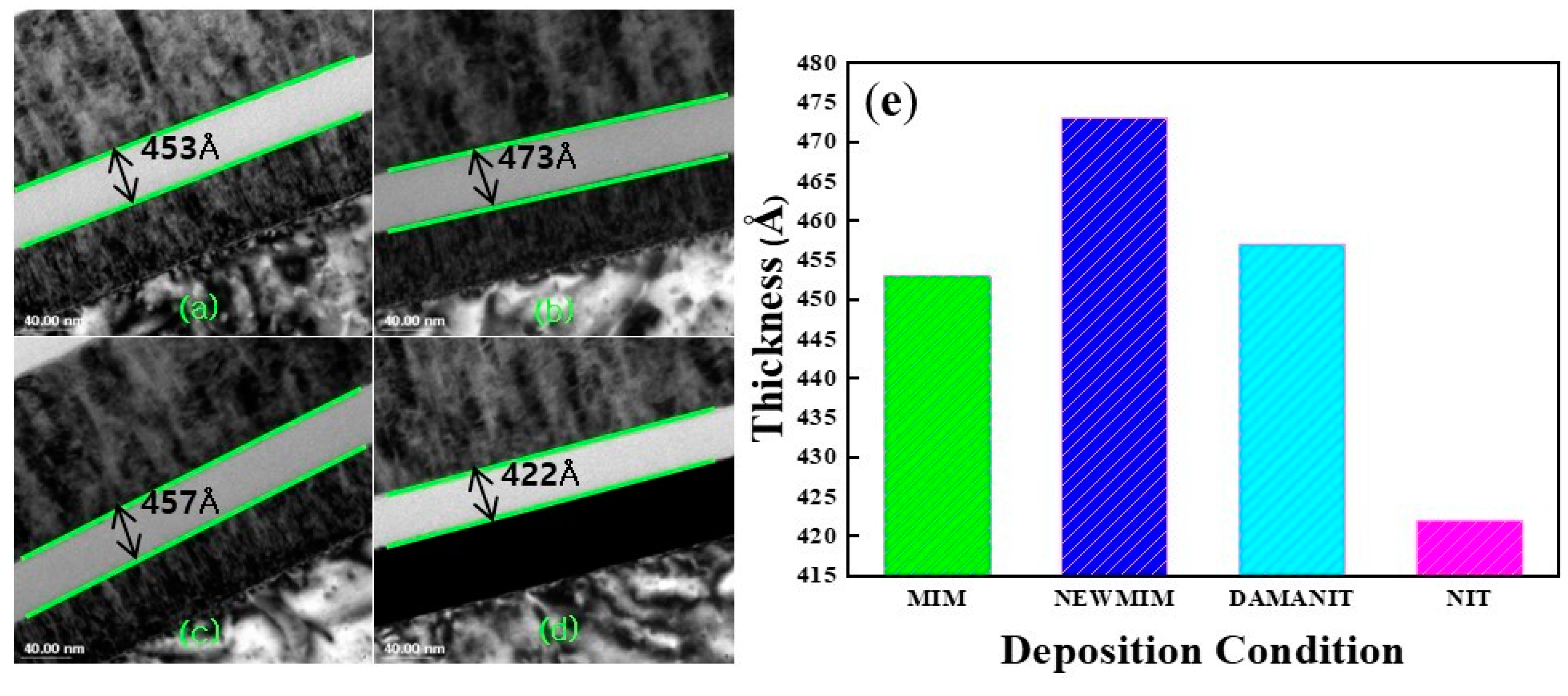
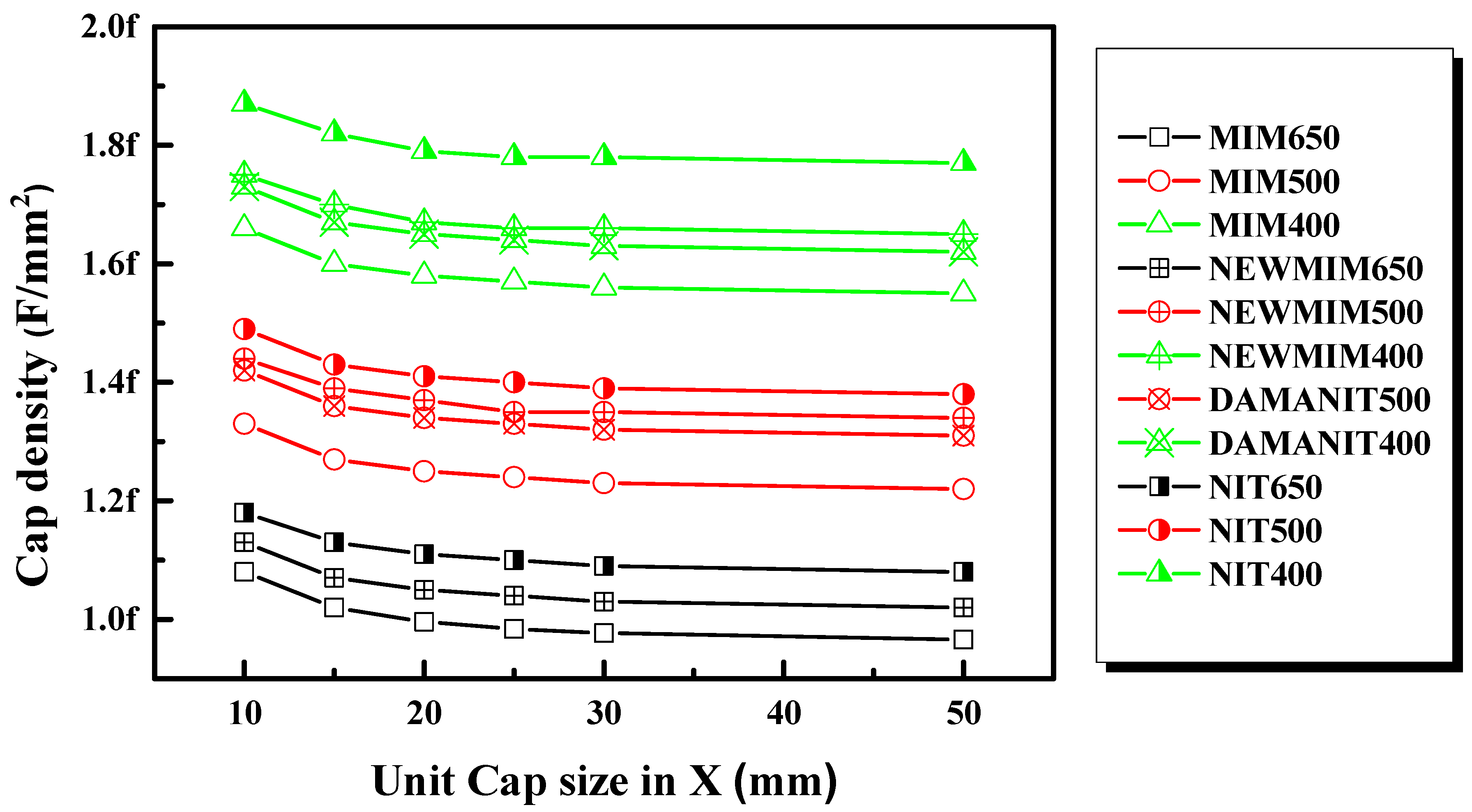

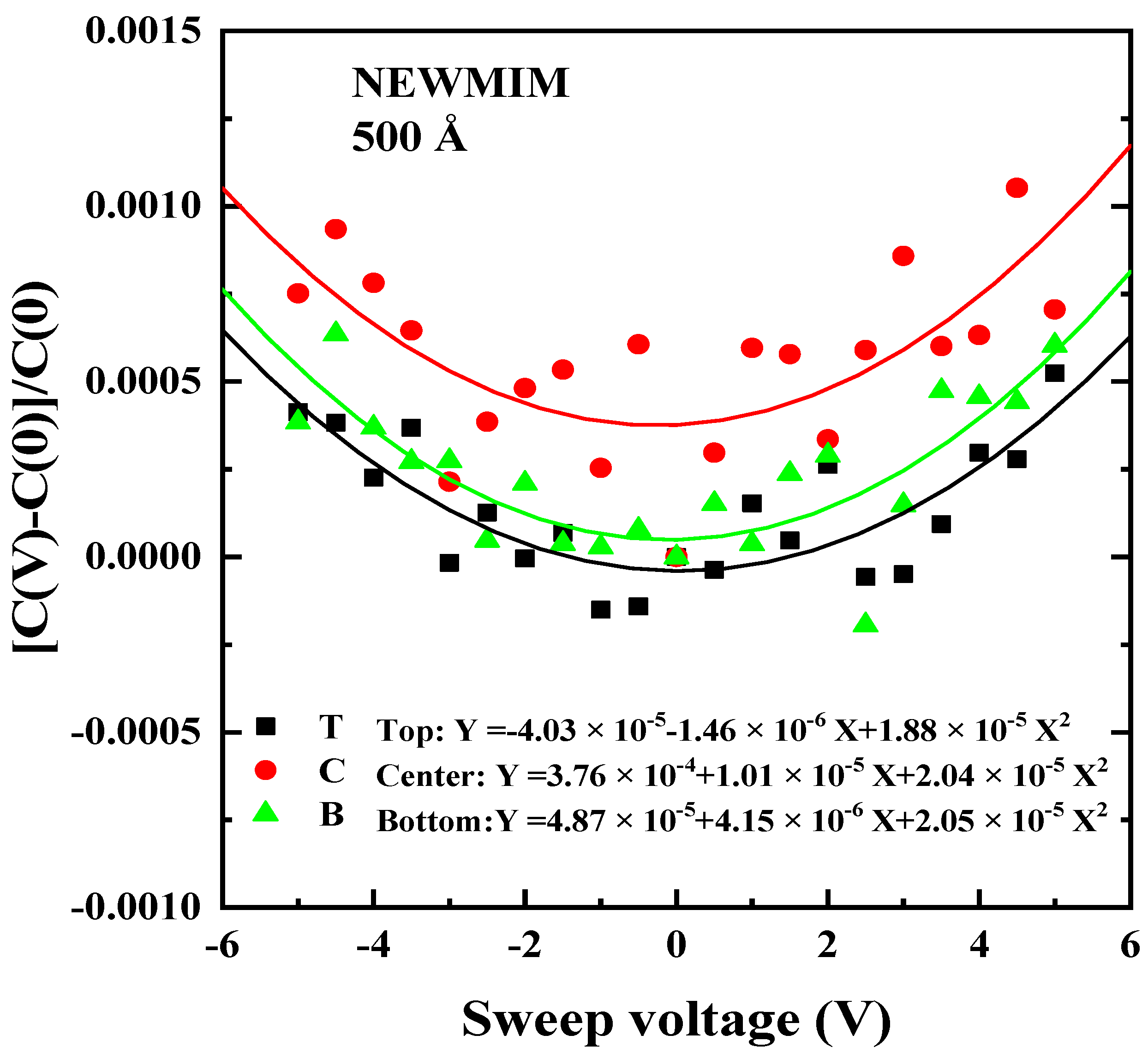
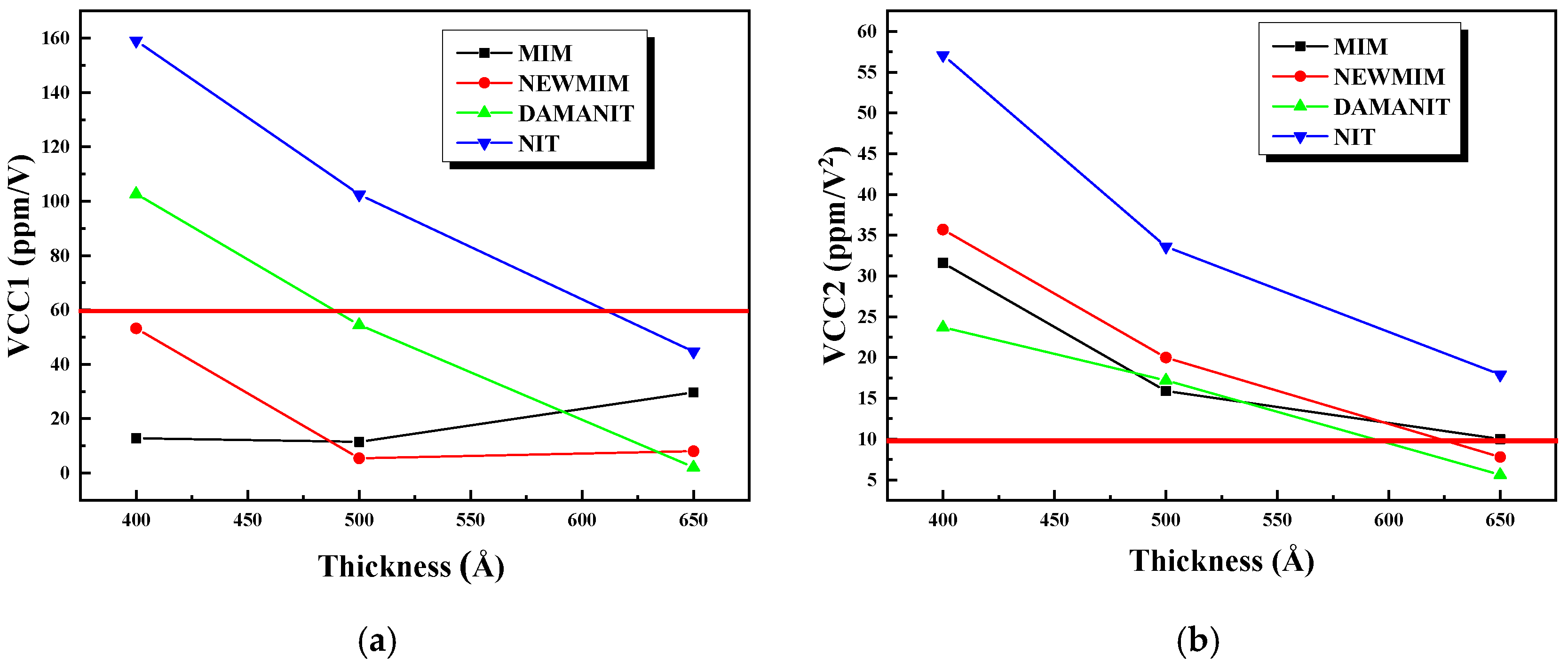
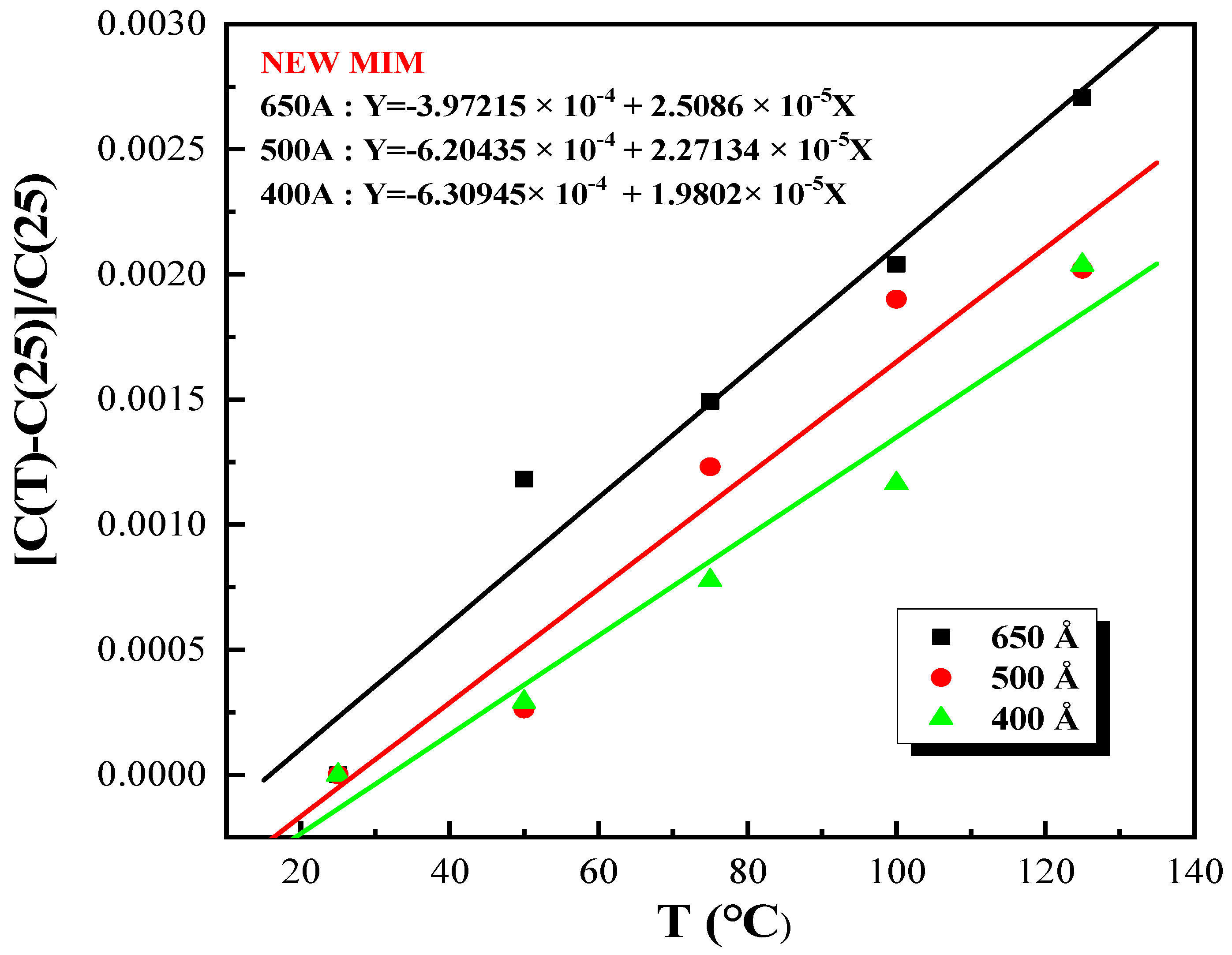


| (a) | MIM | NEW MIM 650 | DAMA NIT | NIT |
| Dep. rate | ~149 Å/s | ~29 Å/s | ~59 Å/s | 88 Å/s |
| Within W/F unit (1σ) | 1.14% | 1.90% | 2.34% | 2.77% |
| W/F to W/F unit (1σ) | 1.58% | 2.21% | 1.05% | 2.30% |
| Stress | −2.23 × 109 | −1.75 × 1010 | −2.34 × 109 | |
| H content (N-H: Si-H) | 12.7%: 8.5% | 22.5%: 0.8% | 10.5%: 7.3% | 4.4%: 14.8% |
| N content (N-H/Si-H) | 1.49 | 28.1 | 1.43 | 0.30 |
| (b) | MIM 650 | NEW MIM 650 | DAMA NIT | NIT 650 |
| Step end control | By time | By time | By time | By time |
| Maximum step time | 4.4 s | 22.8 s | 11.0 s | |
| Endpoint selection | No endpoint | No endpoint | No endpoint | No endpoint |
| Pressure | Servo 4.25 Torr | Servo 4.25 Torr | Servo 4.2 Torr | Servo 4.5 Torr |
| RF power | 690 W | 690 W | 420 W | 425 W |
| Susc. temperature | 400 °C | 400 °C | 400 °C | 400 °C |
| Susceptor spacing | 620 mils | 620 mils | 550 mils | 475 mils |
| N2 | 3800 sccm | 3800 sccm | 2500 sccm | 4000 sccm |
| NH3 | 130 sccm | 50 sccm | 38 sccm | 60 sccm |
| SiH4 | 260 sccm | 100 sccm | 110 sccm | 170 sccm |
| Parameter | Setting |
|---|---|
| Display mode | Cp (parallel capacitor), D (dissipation factor) |
| Sweep voltage (V) | −5~5 |
| Step (V) | 0.5 |
| Oscillation | 0.025 |
| Frequency (kHz) | 100 |
| Capacitor size (μm2) | 10 × 10, 15 × 15, 20 × 20, 25 × 25, 30 × 30, 50 × 50 |
| Measurement points | Three points (top, center, and bottom) |
| Temperature (°C) | 25, 50, 75, 100, 125 |
| Deposition Condition | MIM | NEWMIM | DAMANIT | NIT |
|---|---|---|---|---|
| CD (fF/μm2) | 1.3256 | 1.3203 | 1.3103 | 1.3606 |
| Thickness (TEM, Å) | 453 | 473 | 457 | 422 |
| k-value (ε0·ε) | 6.00 × 10−17 | 6.25 × 10−17 | 5.99 × 10−17 | 5.74 × 10−17 |
| MIM 650 DEP | NEW MIM 650 DEP | DAMA NIT 650 DEP | NIT 650 DEP | |
|---|---|---|---|---|
| Deposition rate (Å/s) | ~149 | ~29 | ~59 | 88 |
| Within W/F unit (1σ, %) | 1.14 | 1.90 | 2.34 | 2.77 |
| W/F to W/F unit (1σ, %) | 1.58 | 2.21 | 1.05 | 2.30 |
| Stress | −2.23 × 109 | −1.75 × 1010 | −2.34 × 109 | - |
| H content (N-H:Si-H) | 12.7%:8.5% | 22.5%:0.8% | 10.5%:7.3% | 4.4%:14.8% |
Disclaimer/Publisher’s Note: The statements, opinions and data contained in all publications are solely those of the individual author(s) and contributor(s) and not of MDPI and/or the editor(s). MDPI and/or the editor(s) disclaim responsibility for any injury to people or property resulting from any ideas, methods, instructions or products referred to in the content. |
© 2024 by the authors. Licensee MDPI, Basel, Switzerland. This article is an open access article distributed under the terms and conditions of the Creative Commons Attribution (CC BY) license (https://creativecommons.org/licenses/by/4.0/).
Share and Cite
Choi, T.-M.; Jung, E.-S.; Yoo, J.-U.; Lee, H.-R.; Pyo, S.-G. Capacitance–Voltage Fluctuation of SixNy-Based Metal–Insulator–Metal Capacitor Due to Silane Surface Treatment. Micromachines 2024, 15, 1204. https://doi.org/10.3390/mi15101204
Choi T-M, Jung E-S, Yoo J-U, Lee H-R, Pyo S-G. Capacitance–Voltage Fluctuation of SixNy-Based Metal–Insulator–Metal Capacitor Due to Silane Surface Treatment. Micromachines. 2024; 15(10):1204. https://doi.org/10.3390/mi15101204
Chicago/Turabian StyleChoi, Tae-Min, Eun-Su Jung, Jin-Uk Yoo, Hwa-Rim Lee, and Sung-Gyu Pyo. 2024. "Capacitance–Voltage Fluctuation of SixNy-Based Metal–Insulator–Metal Capacitor Due to Silane Surface Treatment" Micromachines 15, no. 10: 1204. https://doi.org/10.3390/mi15101204






